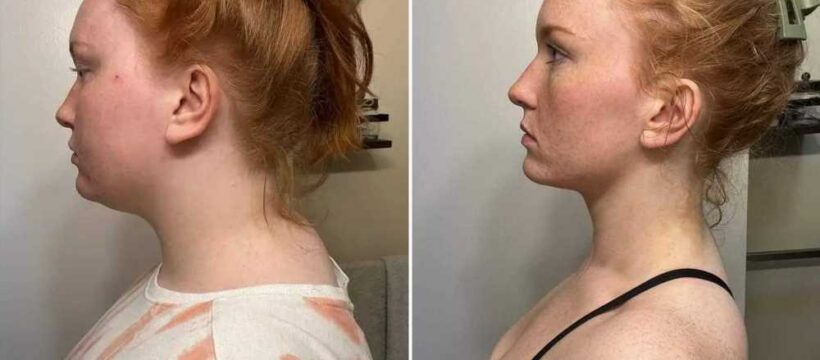HOW many times have you zoned out, only to come to and realise you're crumpled over your phone or laptop?
Poor posture leave many of us to develop a curve at the top of our spine – also known as a neck hump.
If you're left despairing that your Dowager's bump is permanent, you're in luck.
A woman has gone viral on TikTok after revealing a simple method that she claims can fix neck humps.
Katie Blake developed a hump herself after years of maintaining poor posture.
Last year, the 24-year-old was inspired to treat it by using exercises she found online and soon came up with her own routine.
Read more on posture
I’m an osteopath – here’s how to to get rid of that ‘unsightly’ neck hump
What your posture says about YOU – and the serious health risks you face
Katie has now gone viral on TikTok, with her clip racking up four million views so far.
“I was able to correct my Dowager's Hump using this routine,” Katie, a content creator from Maine, US, told http://NeedToKnow.co.uk
“The purpose of the routine is to stretch the tight muscles and strengthen the muscles to hold your head and shoulders back.”
A Dowager's Hump – also known as hyperkyphosis – is when a person has excessive curvature of the spine, resulting in some patients developing a ‘hump’ at the bottom of their neck.
Most read in Health

Influencer dies at 35 and pens her farewell letter saying ‘go grab life’

The 3 most ‘undetectable’ cancers revealed & how to spot them early enough

Warning as mum, 40, loses limbs after eating undercooked fish for dinner

Millions called to get Covid booster jabs from today – check if you’re eligible
Katie claims her own hump is due to bad posture.
Sharing her step-by-step routine to getting rid of humps, she also makes a point to explain that this method may not work for everyone, as poor posture can be linked to other issues.
KATIE’S STEP-BY-STEP ROUTINE
Step 1: Stick your neck out before pulling it back and tucking your chin, like a chicken – repeat this move 10 times.
Step 2: Shrug your shoulders 10 times.
Step 3: Put your hands together, palms touching, and stick them above your head and press your hands up 10 times.
Step 4: Keep your hands together and do the same movement behind your head, fingers pointing back, for another 10 times.
Step 5: Alternate rolling your shoulders forwards and backwards for three sets of 10.
Step 6: Place a foam roller under your neck and gently push up on your chin.
She added: “This may cause your neck to crack but don’t force anything.
“You can also just rest your neck on the roller for a lighter stretch.
“I did this two times a day, once in the morning and once before bed.
“After around eight months my neck was back in position.”
In the TikTok, Katie shares a photo of her neck before and after in a series of clips that include her performing the routine.
The post has over 441,000 likes, as well as hundreds of comments from users.
Lorraine said: “I’m a physiotherapist and yes these exercises actually work, consistency is key and also genetics play an important role as well.”
Felix commented: “The cracking going on when I rolled my shoulders is insane."
“This is actually accurate. My physical therapist had me do this to improve my posture and neck pain,” added someone else.
“Me completely hunched over watching this,” joked Adrianna.
“Just did it. It sounded like a bowl of rice crispies…..snap crackle pop,' said Jennifer.
A top osteopath, Brendon Talbot from Canada, previously demonstrated how you can get rid of a neck hump and improve your posture over time, with one simple movement.
READ MORE SUN STORIES
Holly Willoughby pays emotional tribute to This Morning doc after her sudden death
I spent £2k on my 13 ‘fake’ babies, my dad says it’s bizarre… who cares
It involves tucking your chin as far as you can and gently pressing it back and down, before using your other hand to rotate the head down.
It can also help relieve headaches, migraines, neck pain and upper back pain, he said.
Source: Read Full Article









